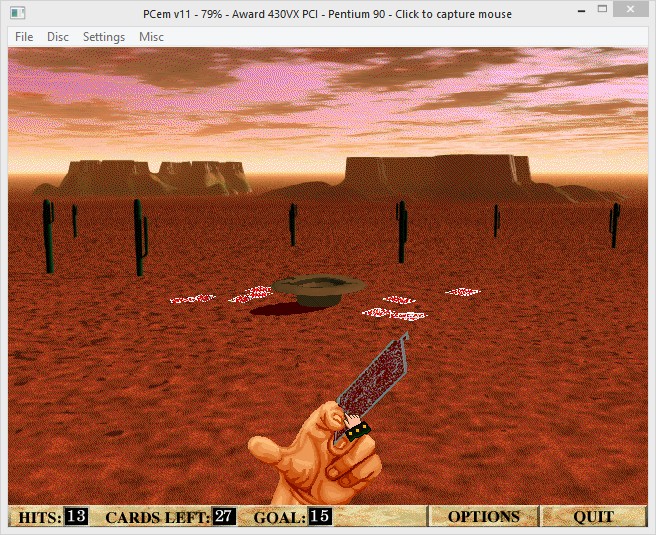
The Hoyle name, long since detached from Edmond Hoyle and now a brand name of the United States Playing Card Company (alongside Bicycle and Bee, among others), has regardless remained synonymous with the act of playing games with cards. But alongside branded playing cards with distinctive Joker and Ace of Spades designs, and various licensed and unlicensed "According to Hoyle" books, the Hoyle name is also associated with a long-running series of computer games, initially launched by Sierra On-Line with 1989's Hoyle Official Book of Games Volume 1.
In the years since then, Sierra continued the Hoyle series, with further entries focusing entirely on solitaire games (Volume 2), traditional board games like Checkers and Parcheesi (Volume 3), and then competitive card games again (Hoyle Classic Card Games). These were fairly low-key releases; I didn't even know Volume 3 or Classic Card Games existed until somewhere around 2014. But I was fairly well familiar with Sierra's entries past what I call the Multimedia Era: that magical time between 1993 and 1998 when seemingly everyone wanted to make games for Windows on that popular computer peripheral, the CD-ROM drive. Sierra started releasing these new Hoyle games in quite a high volume starting in 1996 - though no longer designed and programmed by Warren Schwader, and no longer featuring characters from other Sierra games. Hoyle Casino, Hoyle Word Games, and this one, Hoyle Classic Solitaire.

La Belle Lucie is kind of hard. It's a lot harder when you don't get the free "Draw." (Also, get a load of how grainy the buttons and background are. Eww.)
HCS is essentially an enhanced update of the Book of Games Vol.2, containing more or less the same roster of games, everything from Klondike to La Belle Lucie, but also at least one that I've never seen anywhere else. In all honesty, this game doesn't handle especially well, especially not on modern computers (for some reason, these latter-day Windows 3.x games rarely do), but it's kind enough to keep track of which games you've won at least once, and offers a reasonable selection of decks, backgrounds, and music (if you have the CD in). By modern standards, the backgrounds don't look especially great, suffering quite badly from having to be degraded to display properly on the lowest common denominator for system requirements.

Bowling - Pizza and beer not included.
Hoyle Classic Solitaire also contains an unusual rule set called Bowling (which also appeared in Book of Games Vol.2), where 1-4 players compete to line up "pins." The rules say you can technically assign any card rank to any pin, but the cards have to still be in order from low to high, so you can't put a King on pin 9 and expect to put anything in pin 10 afterwards. If for some reason you can't fit a card anywhere in the pins, you have to put it in the gutter before you can draw another. 3 cards in the gutter, and that ball's over. 3 cards in the second gutter, and that's the end of the frame and your score is tallied, the deck is shuffled and the cycle starts anew. It's a little difficult to explain, but the version on SolitaireNetwork.com is fairly accurate (in part due to the web site being run by Warren Schwader...hmm).

"Maybe I have hit bottom, and maybe I do look like hell. Lord knows the most exercise I've gotten has been tipping the bottle and throwing cards into my hat.
--Tex Murphy
But the real reason I'm interested in this specific solitaire computer game is the Card Flick minigame. Hoyle Classic Solitaire may, in fact, be the only card game to include the favored cowboy-and-private-investigator pastime, and while the physics are at times unpredictable, and the game speed varies wildly depending on how fast your computer is, it still works about as well as the real thing. Under normal circumstances, winning a round of any of the actual solitaire games gives you the chance to "Take a shot!" Landing the one card in the hat triggers a bombastic winning animation with all the fireworks and trumpets that 1996 could possibly handle.
The Card Flick button in the main menu, however, turns a silly little end-game diversion into a full-on arcade experience. Making a certain number of hits on the target advances you to the next stage, which is ultimately just another background. There are occasional easter eggs for hitting extremely specific portions of the screen, but they're even less predictable than trying to hit the hat (or goblet, or oversized popcorn bucket). Maybe it's the nostalgia talking, but there's still a certain charm to it. Maybe the fact that it plays like something hastily slapped together in Macromedia Director, or the Doom-like hand swaying across the bottom of the screen (which you can set from "decaf" to "espresso" to affect how randomly it moves). But Card Flick, while objectively not good enough to warrant owning the whole collection, does give Hoyle Classic Solitaire a little edge to help it stand out, in a world where shareware solitaire collections were quickly becoming dime-a-dozen, and the likes of Hardwood Solitaire were just rising to prominence.

HEYYYY BATTA BATTA BATTA BATTA SUH-WING BATTA